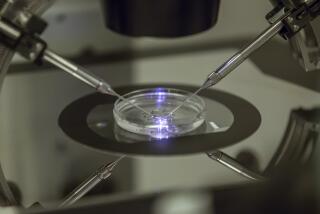Some Studies See Ills for In Vitro Children
- Share via
In vitro fertilization has birthed a million babies worldwide, but now there are glimmerings of concern that the 25-year-old technology and other methods known collectively as assisted reproductive technology are causing several rare medical abnormalities.
A pair of studies in the last three months have linked in vitro fertilization and a related method called intracytoplasmic sperm injection, to a fourfold to sixfold increased risk for a condition known as Beckwith-Wiedemann syndrome, an overgrowth disorder typified by children with enlarged tongues and other organs. Other reports within the last year have spotted a possible increase in Angelman syndrome, in which children have a spectrum of problems including speech impairment and mental retardation.
In 2002, an Australian study published in the New England Journal of Medicine reported that rates of birth defects were twice as high in children conceived in vitro. And a U.S. study in the journal found that such children were more likely to have a low birth weight.
And today, in the journal the Lancet, Dutch researchers report a fourfold to sevenfold increase in the rate of retinoblastoma, a rare cancer of the eye, in children conceived via assisted reproductive technology.
The studies are few, their findings tentative, and the increased risks they point to are in most cases quite slight. Disorders such as retinoblastoma and Beckwith-Wiedemann syndrome are very rare to begin with.
Beckwith-Wiedemann syndrome normally occurs in 1 in 15,000 births; retinoblastoma affects 1 in 17,000.
But a growing number of scientists and doctors think the reports are a cause for unease.
“We’re not saying to families that at this point this ought to affect their decision for in vitro fertilization -- assisted reproductive technology is a miracle for families,” said Dr. Andrew Feinberg, professor of medicine at Johns Hopkins University School of Medicine and co-author of one of the Beckwith-Wiedemann studies. “However, we are saying to the in vitro fertilization community that this needs to be studied in detail.”
A Common Procedure
More than 99,000 assisted reproductive procedures took place in the United States in 2000, the most recent year for which data are available. As a result, about 35,000 babies were born. Since the advent of the technology in the late 1970s, it has become a common, albeit costly, procedure.
The procedure has been a boon to couples who could not conceive a child another way. It involves harvesting eggs from a woman using hormones, fertilizing the egg in a dish with sperm from a man and then growing the embryo for a few days in a culture that provides the necessary nutrients -- and finally returning it to a woman’s body.
While the connection between in vitro fertilization and disorders such as Beckwith-Wiedemann syndrome is only now entering the medical literature, parents of children with some of these diseases have suspected a link for several years.
Melissa, a 33-year-old Baltimore resident who asked that her last name not be used, has a child with Beckwith-Wiedemann. The child was conceived using intracytoplasmic sperm injection. Seeking support online, Melissa said she quickly noticed how many of the Beckwith-Wiedemann parents online had also gone through assisted reproductive technology.
“We were all thinking: ‘Wow, that’s really kind of strange, why are all of us on this message board?’ ” she said.
The list of possible causes is varied, but scientists suspect that culturing eggs and embryos in the lab may be behind the heightened risks.
Animal studies already have raised a number of red flags. For instance, researchers working with mice have found that embryos cultured in laboratories are different in several ways from embryos that are grown inside the body of an animal.
Researchers Richard Schultz and Marisa Bartolomei at the University of Pennsylvania have found that small differences in the amount of salt or amino acids used in the culture can cause certain genes in the embryo to behave aberrantly -- turning on when they should be off, or off when they should be on.
The errors Schultz and Bartolomei have detected crop up in a small collection of genes known as “imprinted” genes. In contrast to the usual way in which genetic information is passed on to a child, these genes retain a chemical mark of their heritage -- an “imprint” -- depending on whether they come from the mother or the father. The imprinting ensures that only one copy of a gene -- from the mother or father -- is turned on.
Angelman syndrome and Beckwith-Wiedemann syndrome are caused by mistakes in such imprinted genes.
Schultz and Bartolomei found in their in vitro animal studies that a gene named H19 -- linked in humans to Beckwith-Wiedemann syndrome -- is improperly imprinted in the parts of the embryo that will later form a placenta. They think this is caused by some abnormal reaction by the embryos to being cultured in the lab.
A recent trend within the in vitro fertilization community may be exacerbating potential problems caused by this embryo culture. Traditionally, embryos are implanted into the mother after a day or so in culture, when the embryo has divided only a few times. In the last few years, more clinics have been growing eggs for about five days to produce an embryo known as a blastocyst -- in an effort to select the best and sturdiest embryos and increase the chances of a successful pregnancy.
“This could potentially be exposing the embryos even more to conditions that could have a long-term health impact,” said John Eppig, senior staff scientist at the Jackson Laboratory in Bar Harbor, Maine.
Scientists suspect abnormalities may be more likely in cases of intracytoplasmic sperm injection, in which sperm cells are injected into the egg. The procedure, pioneered in the 1990s, is used in cases of male sterility.
Some studies have suggested that rates of abnormalities may be higher in children conceived by this method. This could be because the mechanics of the procedure, or the immaturity of the injected sperm that are sometimes used, disrupt the delicate regulation of genes that takes place in a developing embryo.
Scientists said disorders such as Beckwith-Wiedemann syndrome can be tested for and avoided. They are more concerned about subtler errors involving complex traits and genes for which there are no tests.
“It raises the principle that we could have things happening that might take longer to be manifested -- and which might involve behavior,” said Dr. Arthur Beaudet, professor and chair of molecular and human genetics at Baylor College of Medicine in Houston.
More Research Needed
The link between in vitro fertilization and birth abnormalities may still turn out to be spurious. Dr. Sandra Carson, president of the American Society for Reproductive Medicine and professor of obstetrics and gynecology at Baylor, said the findings, while unsettling, must be verified in better studies.
Several fertility experts pointed out that other studies have found no heightened risks.
In addition, the recent in vitro studies have their limitations. Registries of children with birth defects and syndromes may overly represent people who have had in vitro fertilization. In vitro children are more likely to be tested for birth defects, and parents who can afford in vitro fertilization may be more likely to participate in studies because of their education level.
It is also possible that infertile people have genetic problems that make birth defects more likely in their children.
“I’m not debunking it -- I’m just saying we need bigger studies to verify it,” said Dr. Alan DeCherney, professor of obstetrics and gynecology at UCLA Medical Center.
Such studies would have to be large, national enterprises that tracked the health of in vitro children not at birth, but for years to come.
At the same time, scientists said, more research must be conducted in animals. Only that way will they come to understand what happens during the complex, multistep procedure.
But even if the risks are confirmed, DeCherney thinks it unlikely that infertile couples seeking a child will be deterred. “They really want children -- they’ll do almost anything,” he said.






